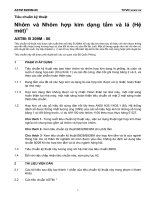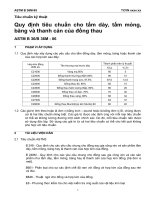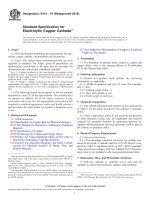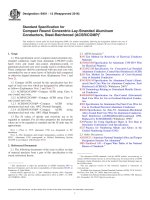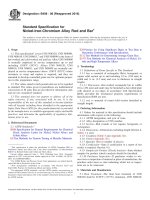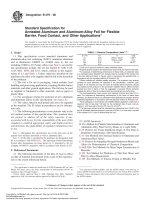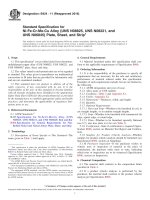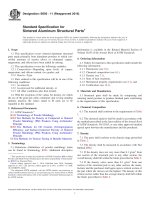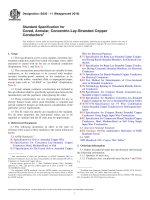Astm b 409 06 (2016)
Bạn đang xem bản rút gọn của tài liệu. Xem và tải ngay bản đầy đủ của tài liệu tại đây (103.2 KB, 5 trang )
Designation: B409 − 06 (Reapproved 2016)
Standard Specification for
Nickel-Iron-Chromium Alloy Plate, Sheet, and Strip1
This standard is issued under the fixed designation B409; the number immediately following the designation indicates the year of
original adoption or, in the case of revision, the year of last revision. A number in parentheses indicates the year of last reapproval. A
superscript epsilon (´) indicates an editorial change since the last revision or reapproval.
Among Brinell Hardness, Vickers Hardness, Rockwell
Hardness, Superficial Hardness, Knoop Hardness, Scleroscope Hardness, and Leeb Hardness
F155 Method of Test for Temper of Strip and Sheet Metals
for Electronic Devices (Spring-Back Method) (Withdrawn
1982)5
1. Scope
2
1.1 This specification covers UNS N08120, UNS N08890,
UNS N08800, UNS N08810, and UNS N088113 in the form of
rolled plate, sheet, and strip. Alloy UNS N08800 is normally
employed in service temperatures up to and including 1100°F
(593°C). Alloys UNS N08120, UNS N08810, UNS N08811,
and UNS N08890 are normally employed in service temperatures above 1100°F (593°C) where resistance to creep and
rupture is required, and they are annealed to develop controlled
grain size for optimum properties in this temperature range.
3. Terminology
3.1 Definitions of Terms Specific to This Standard—The
terms given in Table 1 shall apply.
1.2 The values stated in inch-pound units are to be regarded
as standard. The values given in parentheses are mathematical
conversions to SI units that are provided for information only
and are not considered standard.
1.3 This standard does not purport to address all of the
safety concerns, if any, associated with its use. It is the
responsibility of the user of this standard to become familiar
with all hazards including those identified in the appropriate
Safety Data Sheet (SDS) for this product/material as provided
by the manufacturer, to establish appropriate safety and health
practices, and determine the applicability of regulatory limitations prior to use.
4. General Requirements
4.1 Material furnished under this specification shall conform to the applicable requirements of Specification B906
unless otherwise provided herein.
5. Ordering Information
5.1 It is the responsibility of the purchaser to specify all
requirements that are necessary for the safe and satisfactory
performance of material ordered under this specification.
Examples of such requirements include but are not limited to
the following:
5.1.1 Alloy (Table 2),
5.1.2 Condition (Temper)—Table 3 and Table 4, Appendix
X1, and Specification B906.
5.1.3 Finish—Appendix X1 and Specification B906.
5.1.4 Dimensions—Thickness, width, and length.
5.1.5 Optional Requirements:
5.1.5.1 Sheet and Strip—Whether to be furnished in coil, in
cut straight lengths, or in random straight lengths.
5.1.5.2 Strip—Whether to be furnished with commercial slit
edge, square edge, or round edge.
5.1.5.3 Plate—Whether to be furnished specially flattened
(see 9.7.2); also how plate is to be cut (Specification B906,
Table A3.4 and Table A3.7.
5.1.6 Fabrication Details—Not mandatory but helpful to
the manufacturer:
5.1.6.1 Welding or Brazing—Process to be employed.
5.1.6.2 Plate—Whether material is to be hot-formed.
5.1.7 Certification—State if certification or a report of test
results is required (Specification B906).
2. Referenced Documents
2.1 ASTM Standards:4
B408 Specification for Nickel-Iron-Chromium Alloy Rod
and Bar
B906 Specification for General Requirements for FlatRolled Nickel and Nickel Alloys Plate, Sheet, and Strip
E140 Hardness Conversion Tables for Metals Relationship
1
This specification is under the jurisdiction of ASTM Committee B02 on
Nonferrous Metals and Alloys and is the direct responsibility of Subcommittee
B02.07 on Refined Nickel and Cobalt and Their Alloys.
Current edition approved June 1, 2016. Published June 2016. Originally
approved in 1957. Last previous edition approved in 2011 as B409 – 06 (2011).
DOI: 10.1520/B0409-06R16.
2
For ASME Boiler and Pressure Vessel Code applications see related Specification SB 409 in Section II of that Code.
3
New designations established in accordance with Practice E527 and SAE
J1086, Practice for Numbering Metals and Alloys (UNS).
4
For referenced ASTM standards, visit the ASTM website, www.astm.org, or
contact ASTM Customer Service at For Annual Book of ASTM
Standards volume information, refer to the standard’s Document Summary page on
the ASTM website.
5
The last approved version of this historical standard is referenced on
www.astm.org.
Copyright © ASTM International, 100 Barr Harbor Drive, PO Box C700, West Conshohocken, PA 19428-2959. United States
1
B409 − 06 (2016)
TABLE 1 Product Description
Product
Thickness, in. (mm)
Width, in. (mm)
Hot-rolled plateA
Hot-rolled sheetA
Cold-rolled sheetC
Cold-rolled stripC
3 16
⁄ and over (B906, Table A3.1 and Table A3.2)
0.018 to 0.250 (0.46 to 6.4), incl (B906, Table A3.3)
0.018 to 0.250 (0.46 to 6.4), incl (B906, Table A3.3)
0.005 to 0.250 (0.13 to 6.4), incl (B906, Table A3.3)
(B906,
(B906,
(B906,
(B906,
Table A3.4)B
Table A3.6)
Table A3.6)
Table A3.6)
A
Material 3⁄16 to 1⁄4 in. (4.8 to 6.4 mm), incl, in thickness may be furnished as sheet or plate provided the material meets the specification requirements for the condition
ordered.
B
Hot-rolled plate, in widths 10 in. (254 mm) and under, may be furnished as hot-finished rectangles with sheared or cut edges in accordance with Specification B408,
provided the mechanical property requirements of this specification are met.
C
Material under 48 in. (1219 mm) in width may be furnished as sheet or strip provided the material meets the specification requirements for the condition ordered.
TABLE 2 Chemical Requirements
7. Chemical Composition
Composition Limits, %
Element
Nickel
Chromium
Iron
Manganese, max
Carbon
Copper, max
Silicon, max
Sulfur, max
AluminumC
TitaniumC
Columbium
Molybdenum
Niobium
Tantalum
Phosphorus
Tungsten
Cobalt, max
Nitrogen
Alloy
N08120
35.0 min
39.0 max
23.0 min
27.0 max
remainderA
1.5
0.02 min
0.10 max
0.50
1.0
...
0.03
0.40 max
...
0.20 max
...
0.4 min
0.9 max
2.50 max
...
...
...
...
...
0.040 max
2.50 max
3.0
0.15 min
0.30 max
0.010 max
Alloy
N08890
40.0 min
45.0 max
23.5 min
28.5 max
remainder
1.5
0.06 min
0.14 max
0.75
1.0 min
2.0 max
0.015
0.05 min
0.60 max
0.15 min
0.60 max
...
...
1.0 min
2.0 max
0.2 min
1.0 max
0.10 min
0.60 max
...
...
...
...
...
...
7.1 The material shall conform to the composition limits
specified in Table 2.
Alloys
N08800,
N08810, and
N08811
30.0
35.0
19.0
23.0
39.5
1.5
7.2 If a product (check) analysis is performed by the
purchaser, the material shall conform to the product (check)
analysis variations in Specification B906.
min
max
min
max
minA
8. Mechanical and Other Requirements
8.1 Mechanical Properties—The material shall conform to
the mechanical properties specified in Table 3.
B
...
0.75
1.0
...
0.015
0.15 min
0.60 max
0.15 min
0.60 max
...
...
...
...
...
...
...
...
...
...
...
...
...
...
8.2 Grain Size—Annealed Alloys UNS N08120, UNS
N08810, UNS N08811, and UNS N08890 shall conform to an
average grain size of ASTM No. 5 or coarser.
8.3 Deep-Drawing and Spinning Quality Sheet and Strip—
(Alloy UNS N08800) Shall conform to the grain size and
hardness requirements as provided in Table 4.
8.3.1 The mechanical properties of Table 3 do not apply to
deep drawing and spinning quality sheet and strip.
8.4 Annealing Temperature—Alloy UNS N08120 shall be
annealed at 2150°F (1177°C) minimum, and UNS N08810,
2050°F (1121°C) minimum.
9. Dimensions and Permissible Variations
6. Materials and Manufacture
9.1 Thickness and Weight:
9.1.1 Plate—For plate up to 2 in. (50.8 mm), incl, in
thickness, the permissible variation under the specified thickness and permissible excess in overweight shall not exceed the
amounts prescribed in Table A3.1 in Specification B906.
9.1.1.1 For use with Table A3.1 in Specification B906, plate
shall be assumed to weigh 0.287 lb/in.3 (7.944 g/cm3).
9.1.2 Plate—For plate over 2 in. (50.8 mm) in thickness, the
permissible variations over the specified thickness shall not
exceed the amounts prescribed in Table A3.2 in Specification
B906.
9.1.3 Sheet and Strip—The permissible variations in thickness of sheet and strip shall be as prescribed in Table A3.3 in
Specification B906. The thickness of sheet and strip shall be
measured with the micrometer spindle 3⁄8 in. (9.5 mm) or more
from either edge for material 1 in. (25.4 mm) or over in width
and at any place on strip under 1 in. in width.
6.1 Heat Treatment—The final heat treatment of UNS
N08120 shall be 2150°F (1177°C) minimum, UNS N08810,
2050°F (1121°C) minimum, UNS N08811 and UNS N08890,
2100°F (1149°C) minimum.
9.2 Width or Diameter:
9.2.1 Plate—The permissible variations in width of rectangular plates and diameter of circular plates shall be as
prescribed in Table A3.4 and Table A3.5 in Specification B906.
Boron
A
Iron shall be determined arithmetically by difference.
Alloy UNS N08800: 0.10 max.
Alloy UNS N08810: 0.05–0.10.
Alloy UNS N08811: 0.06–0.10.
C
Alloy UNS N08811: Al + Ti, 0.85–1.20.
B
5.1.8 Samples for Product (Check) Analysis—Whether
samples for product (check) analysis should be furnished (see
7.2).
5.1.9 Purchaser Inspection—If purchaser wishes to witness
tests or inspection of material at place of manufacture, the
purchase order must so state indicating which tests or inspections are to be witnessed (Specification B906).
2
B409 − 06 (2016)
TABLE 3 Mechanical Properties for Plate, Sheet, and Strip
(All thicknesses and sizes unless otherwise indicated)
Alloy
Condition
Tensile Strength, min, psi
(MPa)
UNS
UNS
UNS
UNS
UNS
UNS
N08120
N08800
N08800
N08810
N08811
N08890
Annealed
Annealed
As-rolledBC
Annealed
Annealed
Annealed
90
75
80
65
65
75
UNS
UNS
UNS
UNS
UNS
N08120
N08800
N08810D
N08811D
N08890
Annealed
Annealed
Annealed
Annealed
Annealed
90
75
65
65
75
UNS
UNS
UNS
UNS
UNS
N08120
N08800
N08810D
N08811D
N08890
Annealed
Annealed
Annealed
Annealed
Annealed
90
75
65
65
75
UNS
UNS
UNS
UNS
UNS
N08120
N08800
N08810D
N08811D
N08890
Annealed
Annealed
Annealed
Annealed
Annealed
90
75
65
65
75
Yield StrengthA (0.2 %
offset), min, psi (MPa)
Hot-Rolled Plate
000 (621)
000 (520)
000 (550)
000 (450)
000 (450)
000 (520)
Hot-Rolled Sheet
000 (621)
000 (520)
000 (450)
000 (450)
000 (520)
Cold-Rolled Sheet
000 (621)
000 (520)
000 (450)
000 (450)
000 (520)
Cold-Rolled Strip
000 (621)
000 (520)
000 (450)
000 (450)
000 (520)
Elongation in 2 in. or
50 mm (or 4D), min,
%
40
30
35
25
25
30
000
000
000
000
000
000
(276)
(205)
(240)
(170)
(170)
(205)
30
30
25
30
30
35
40
30
25
25
30
000
000
000
000
000
(276)
(205)
(170)
(170)
(205)
30
30
30
30
35
40
30
25
25
30
000
000
000
000
000
(276)
(205)
(170)
(170)
(205)
30
30
30
30
35
40
30
25
25
30
000
000
000
000
000
(276)
(205)
(170)
(170)
(205)
30
30E
30
30
35
A
Yield strength requirements do not apply to material under 0.020 in. (0.51 mm) in thickness.
As-rolled plate may be given a stress-relieving heat treatment subsequent to final rolling.
As-rolled plate specified “suitable for hot forming” shall be furnished from heats of known good hot-malleability characteristics (see X1.1.1.2). The purchaser must specify
Alloy UNS N08800 or UNS N08810. There are no applicable tensile or hardness requirements for such material.
D
Available only in thicknesses 0.115 in. (2.92 mm) and over.
E
Not applicable for thickness under 0.010 in. (0.25 mm).
B
C
TABLE 4 Grain Size and Hardness for Alloy UNS N08800 Cold-Rolled, Deep-Drawing, and Spinning Quality Sheet and Strip
Thickness
0.050 (1.3) and less
Over 0.050 to 0.250 (1.3 to 6.4), incl
0.005D to 0.010 (0.13 to 0.25), incl
Over 0.010 to 0.125 (0.25 to 3.2), incl
Calculated Diameter of Average
Grain Section, max, in. (mm)
Sheet (56 in. (1.42 m) Wide and Under)
0.0030 (0.075)
0.0043 (0.110)
Strip (12 in. (305 mm) Wide and Under)C
0.0009 (0.022)
0.0030 (0.075)
Corresponding
ASTM MicroGrain Size No.
Rockwell BAB
Hardness, max
4.5
3.5
86
86
8E
4.5
88E
86
A
For Rockwell or equivalent hardness conversions see Hardness Conversion Tables E140.
Caution should be observed in using the Rockwell test on thin material, as the results may be affected by specimen thickness. For thicknesses under 0.050 in. (1.3 mm),
the use of the Rockwell superficial or the Vickers hardness test is suggested.
C
Sheet requirements (above) apply to strip thicknesses over 0.125 in. (3.2 mm), and for all thicknesses of strip over 12 in. (305 mm) in width.
D
For ductility evaluations for strip under 0.005 in. (0.13 mm) in thickness, the spring-back test such as described in Test Method F155, is often used and the manufacturer
should be consulted.
E
Accurate grain size and hardness determinations are difficult to make on strip under 0.005 in. (0.13 mm) in thickness and are not recommended.
B
9.4.1 The edgewise curvature (depth of chord) of flat sheet,
strip, and plate shall not exceed 0.05 in. multiplied by the
length in feet (0.04 mm multiplied by the length in centimetres).
9.4.2 Straightness for coiled strip material is subject to
agreement between the manufacturer and the purchaser.
9.2.2 Sheet and Strip—The permissible variations in width
for sheet and strip shall be as prescribed in Table A3.6 in
Specification B906.
9.3 Length:
9.3.1 Sheet and strip of all sizes may be ordered to cut
lengths, in which case a variation of 1⁄8 in. (3.18 mm) over the
specified length shall be permitted.
9.3.2 Permissible variations in length of rectangular plate
shall be as prescribed in Table A3.7 in Specification B906.
9.5 Edges:
9.5.1 When finished edges of strip are specified in the
contract or order, the following descriptions shall apply:
9.5.1.1 Square-edge strip shall be supplied with finished
edges, with sharp, square corners, without bevel or rounding.
9.4 Straightness:
3
B409 − 06 (2016)
TABLE 5 Permissible Variations From Flatness of Rectangular, Circular, and Sketch Plates
NOTE 1—Permissible variations apply to plates up to 12 ft (366 cm) in length, or to any 12 ft (366 cm) of longer plates.
NOTE 2—If the longer dimension is under 36 in. (914 mm), the permissible variation is not greater than 1⁄4 in. (6.35 mm).
NOTE 3—The shorter dimension specified is considered the width, and the permissible variation in flatness across the width does not exceed the tabular
amount of that dimension.
NOTE 4—The maximum deviation from a flat surface does not customarily exceed the tabular tolerance for the longer dimension specified.
Permissible Variations from a Flat Surface for Thickness and Widths Given, in. (mm)
Specified Thickness
⁄ to 1⁄4, excl
1⁄4 to 3⁄8, excl
3⁄8 to 1⁄2, excl
1⁄2 to 3⁄4, excl
3⁄4 to 1, excl
1 to 2, excl
2 to 4, incl
3 16
4.76 to 6.35, excl
6.35 to 9.52, excl
9.52 to 12.70, excl
12.70 to 19.05, excl
19.05 to 25.4, excl
25.4 to 50.8, excl
50.8 to 101.6, incl
To 48
(1220),
excl
48 to 60
(1220
to
1520),
excl
60 to 72
(1520
to
1830),
excl
34
⁄
11⁄16
1 ⁄2
1 ⁄2
1 ⁄2
1 ⁄2
1 ⁄4
11⁄16
3 ⁄4
9⁄16
9⁄16
9⁄16
9⁄16
5⁄16
1 1 ⁄4
15⁄16
11⁄16
5 ⁄8
5 ⁄8
9⁄16
3 ⁄8
19.05
17.46
12.70
12.70
12.70
12.70
6.35
27.0
19.05
14.29
14.29
14.29
14.29
7.94
31.7
23.81
17.46
15.88
15.88
14.29
9.52
72 to 84
(1830
to
2130),
excl
Inches
1 3 ⁄8
1 1 ⁄8
3⁄ 4
5 ⁄8
5 ⁄8
9⁄16
7⁄16
Millimetres
34.9
28.6
19.05
15.88
15.88
14.29
11.11
84 to 96
(2130
to
2440),
excl
96 to
108
(2440
to
2740),
excl
108 to
120
(2740
to
3050),
excl
120 to
144
(3050
to
3660),
excl
144
(3660)
and
Over
1 5 ⁄8
1 3 ⁄8
15⁄16
13⁄16
3⁄4
11⁄16
1 ⁄2
1 5⁄8
17⁄16
1 1⁄8
1 1⁄8
13⁄16
11⁄16
9⁄16
...
19⁄16
1 1 ⁄4
1 1 ⁄8
15⁄16
11⁄16
5 ⁄8
...
1 7 ⁄8
17⁄16
1 1 ⁄8
1
3 ⁄4
3 ⁄4
...
...
1 3 ⁄4
1 3 ⁄8
1 1 ⁄8
1
7 ⁄8
41.3
35.0
23.8
20.64
19.05
17.46
12.70
41.3
36.5
28.6
28.6
20.64
17.46
14.29
...
39.7
31.7
28.6
23.81
17.46
15.88
...
47.6
35.0
28.6
25.4
19.05
19.05
...
...
44.4
34.9
28.6
25.4
22.22
10.2 The measurement of average grain size may be carried
out by the planimetric method, the comparison method, or the
intercept method described in Specification B906. In case of
dispute, the “referee” method for determining average grain
size shall be the planimetric method.
9.5.1.2 Round-edge strip shall be supplied with finished
edges, semicircular in form, the diameter of the circle forming
the edge being equal to the strip thickness.
9.5.1.3 When no description of any required form of strip
edge is given, it shall be understood that edges such as those
resulting from slitting or shearing will be acceptable.
9.5.1.4 Sheet shall have sheared or slit edges.
9.5.1.5 Plate shall have sheared or cut (machined, abrasivecut, powder-cut, or inert arc-cut) edges, as specified.
10.3 For purposes of determining compliance with the
specified limits for requirements of the properties listed in
Specification B409, an observed value or a calculated value
shall be rounded as indicated below, in accordance with the
rounding methods in Specification B906.
9.6 Squareness (Sheet):
9.6.1 For sheets of all thicknesses, the angle between
adjacent sides shall be 90 6 0.15° (1⁄16 in. in 24 in.) (1.59 mm
in 610 mm).
Test
Elongation
Grain size:
0.0024 in. (0.060 mm) or
larger
less than 0.0024 in. (0.060
mm)
9.7 Flatness:
9.7.1 There shall be no flatness requirements for “deepdrawing quality” and “spinning quality” sheet and strip (see
X1.1.3).
9.7.2 Standard flatness tolerances for plate shall conform to
the requirements of Table 5. “Specially-flattened” plate when
so specified, shall have permissible variations in flatness as
agreed upon between the manufacturer and the purchaser.
Rounded Unit for Observed
or Calculated Value
nearest 1 %
nearest multiple of 0.0002
in. (0.005 mm)
nearest multiple of 0.0001
in. (0.002 mm)
11. Product Marking
11.1 Each bundle or shipping container shall be marked
with the name of the material; condition (temper); this specification number; the size; gross, tare, and net weight; consignor
and consignee address; contract or order number; or such other
information as may be defined in the contract or order.
10. Test Methods
10.1 The chemical composition, mechanical, and other
properties of the material as enumerated in this specification
shall be determined, in case of disagreement, in accordance
with the methods in Specification B906.
12. Keywords
12.1 plate; sheet; strip; UNS N08120; UNS N08800; UNS
N08801; UNS N08810; UNS N08811; UNS N08890
4
B409 − 06 (2016)
APPENDIX
(Nonmandatory Information)
X1. CONDITIONS (TEMPERS) AND FINISHES
X1.1 This appendix lists the conditions and finishes in
which plate, sheet, and strip are normally supplied. These are
subject to change and the manufacturer should be consulted for
the latest information available.
X1.1.2 Plate, Cold Rolled:
X1.1.2.1 Annealed—Soft with an oxide surface; available
with a descaled surface when so specified.
X1.1.3 Sheet, Hot-Rolled, Annealed, and Pickled—Soft
with a pickled matte finish. Properties similar to X1.1.4.1 but
with broader thickness tolerances. Not suggested for applications where the finish of a cold-rolled sheet is considered
essential, or for deep drawing, or spinning.
X1.1.1 Plate, Hot Rolled:
X1.1.1.1 Annealed—Soft with an oxide surface, and suitable for heavy cold forming. Available with a descaled surface,
when so specified.
X1.1.1.2 As-Rolled—With an oxide surface. Available with
a descaled surface, when so specified. Suitable for flat work,
mild forming, or tube sheets. When intended for tube sheets,
specify that plates are to be specially flattened. When intended
for hot forming, this should be indicated on the purchase order
so that the manufacturer may select appropriate material.
X1.1.4 Sheet and Strip, Cold-Rolled:
X1.1.4.1 Annealed—Soft with a descaled or bright annealed
finish.
X1.1.4.2 Deep-Drawing or Spinning Quality—Similar to
X1.1.4.1, except furnished to controlled hardness and grain
size and lightly leveled.
ASTM International takes no position respecting the validity of any patent rights asserted in connection with any item mentioned
in this standard. Users of this standard are expressly advised that determination of the validity of any such patent rights, and the risk
of infringement of such rights, are entirely their own responsibility.
This standard is subject to revision at any time by the responsible technical committee and must be reviewed every five years and
if not revised, either reapproved or withdrawn. Your comments are invited either for revision of this standard or for additional standards
and should be addressed to ASTM International Headquarters. Your comments will receive careful consideration at a meeting of the
responsible technical committee, which you may attend. If you feel that your comments have not received a fair hearing you should
make your views known to the ASTM Committee on Standards, at the address shown below.
This standard is copyrighted by ASTM International, 100 Barr Harbor Drive, PO Box C700, West Conshohocken, PA 19428-2959,
United States. Individual reprints (single or multiple copies) of this standard may be obtained by contacting ASTM at the above
address or at 610-832-9585 (phone), 610-832-9555 (fax), or (e-mail); or through the ASTM website
(www.astm.org). Permission rights to photocopy the standard may also be secured from the Copyright Clearance Center, 222
Rosewood Drive, Danvers, MA 01923, Tel: (978) 646-2600; />
5
